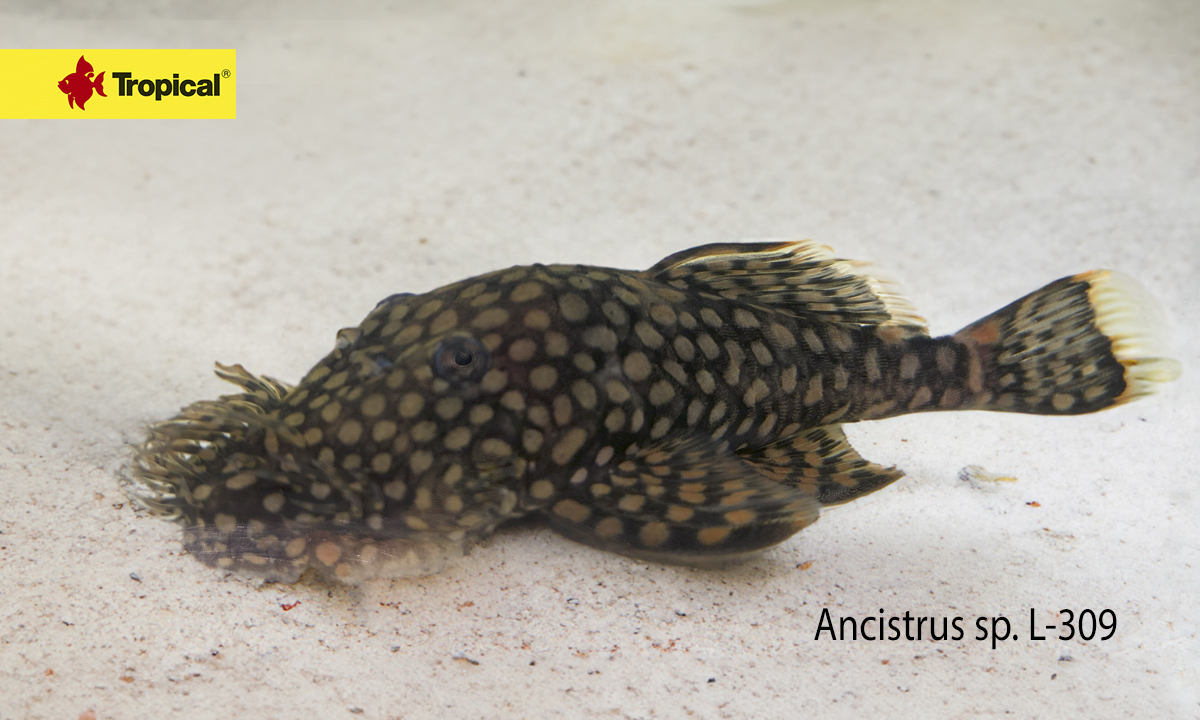Ancistrus sp. L-309 – a rare beauty
Ancistrus sp. L-309 is, in my opinion, one of the most beautiful loricariids of the genus Ancistrus. It was discovered quite recently, in 2002, in the Rio Tapajos River in Brazil. It does not yet have a systematic name and is listed as L-309 in all publications.
Where does Ancistrus sp. L-309 live?
The Rio Tapajos is one of Brazil’s major rivers, a right-bank tributary of the Amazon River. Its waters are described as clear waters. The water at the site where this ancistrus was caught was tested for physicochemical parameters. The following results were recorded: temperature – 29°C, pH – 5.5, conductivity – 20 µS/cm.

As you can see, this fish lives in water that is very soft, quite acidic and warm. So these are quite different environmental conditions from those in which popular varieties of ancistrus are kept in aquariums. Bear it in mind when you decide to breed this fish.
Aquarium for Ancistrus sp. L-309
An aquarium for a group of 10 fish should be 80-100 cm long, 40-50 cm wide and about 35 cm high. You also need to robust filtration and strong water movement, as well as extremely good oxygenation. In addition, you must try to keep nitrate and phosphate levels as low as possible.
What to feed Ancistrus sp. L-309?
Interestingly, the diet of this ancistrus is not typically plant-based. Twice a week it is worth giving it food based on animal protein, such as Tropical Insect Menu size S and Tropical Carnivore. Of the plant foods, all those containing spirulina will be suitable, such as Tropical Super Spirulina Forte and Tropical Super Spirulina Forte Mini Granules. It is necessary to provide the fish with access to soft wood, the kind that lies in water for a long time.

What does spawning look like in L-309?
The spawning of these fish is identical to that of other representatives of the genus Ancistrus. The male chases the female into the cave, then traps her, that is, locks her in the cave, and does not release her until she spawns. The male selects the cave to be sure that his body almost completely covers the entrance hole.

Like other loricariids, this species can also be stimulated to spawn. For this purpose you must feed them heavily, and then change the water to cooler and softer. This usually helps encourage the fish to spawn.
Successful spawning can be achieved in water with a temperature of 26-27°C, a pH of 5.5-6.5, a hardness of about 2-3 kH and a conductivity of 250 µS/cm or less.
A beautiful but rare aquarium resident
Ancistrus sp. L-309 is not a frequent resident of aquariums. But why? There may be several reasons, and they probably overlap. First, this species was discovered recently. Secondly, these are fish that mature late, grow slowly and are not very prolific. Spawning is carried out by individuals 8-9 cm in size. However, such dimensions is reached by L-309 only in the 3rd-4th year. Ultimately, this species grows to 11-12 cm. The female lays about 15-25 grains of fairly large eggs (the number of eggs depends on the size and age of the female).
The eggs develop 7-8 days at 27°C. Then, for almost two weeks, the fry resorbs the yolk sacs and begins to search for food. The slow growth of the juveniles means that the commercial size, which is about 3.5-4 cm, is reached by the fish only after 6-7 months. By ancistrus standards, this is a very long time. Hence, probably, the high price of these fish and their little popularity. They are not included on export lists too often, either.










